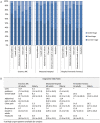Validity of the Manchester Triage System in emergency care: A prospective observational study
- PMID: 28151987
- PMCID: PMC5289484
- DOI: 10.1371/journal.pone.0170811
Validity of the Manchester Triage System in emergency care: A prospective observational study
Abstract
Objectives: To determine the validity of the Manchester Triage System (MTS) in emergency care for the general population of patients attending the emergency department, for children and elderly, and for commonly used MTS flowcharts and discriminators across three different emergency care settings.
Methods: This was a prospective observational study in three European emergency departments. All consecutive patients attending the emergency department during a 1-year study period (2010-2012) were included. Validity of the MTS was assessed by comparing MTS urgency as determined by triage nurses with patient urgency according to a predefined 3-category reference standard as proxy for true patient urgency.
Results: 288,663 patients were included in the analysis. Sensitivity of the MTS in the three hospitals ranged from 0.47 (95%CI 0.44-0.49) to 0.87 (95%CI 0.85-0.90), and specificity from 0.84 (95%CI 0.84-0.84) to 0.94 (95%CI 0.94-0.94) for the triage of adult patients. In children, sensitivity ranged from 0.65 (95%CI 0.61-0.70) to 0.83 (95%CI 0.79-0.87), and specificity from 0.83 (95%CI 0.82-0.83) to 0.89 (95%CI 0.88-0.90). The diagnostic odds ratio ranged from 13.5 (95%CI 12.1-15.0) to 35.3 (95%CI 28.4-43.9) in adults and from 9.8 (95%CI 6.7-14.5) to 23.8 (95%CI 17.7-32.0) in children, and was lowest in the youngest patients in 2 out of 3 settings and in the oldest patients in all settings. Performance varied considerably between the different emergency departments.
Conclusions: Validity of the MTS in emergency care is moderate to good, with lowest performance in the young and elderly patients. Future studies on the validity of triage systems should be restricted to large, multicenter studies to define modifications and improve generalizability of the findings.
Conflict of interest statement
The authors have declared that no competing interests exist.
Figures



References
-
- Australasian College for Emergency Medicine. Access Block and Overcrowding in Emergency departments. 2004.
-
- NHS England. Transforming urgent and emergency care services in England—Urgent and Emergency Care Review. 2013.
Publication types
MeSH terms
LinkOut - more resources
Full Text Sources
Other Literature Sources
Medical

